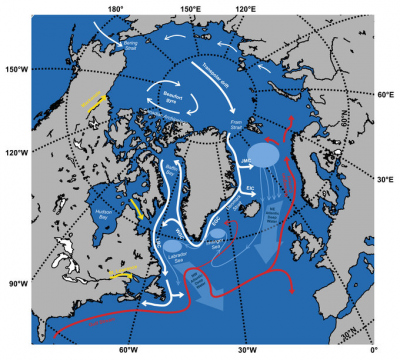Die Inhalte dieser Seite sind leider nicht auf Deutsch verfügbar.
Seitenpfad:
- ArcTrain
- HB-1-11
HB-1-11
Sensitivity of open-ocean convection in the subarctic North Atlantic Ocean to meltwater run-off from Northern Hemisphere ice sheets
| PhD student : | Annegret Krandick |
| Project supervisors : | A. Paul, M. Losch, M.Schulz (Germany) |
| S. Marschall (Canada) |
Key hypothesis
Entrainment of freshwater in a coastal current renders open-ocean convection and the AMOC less sensitive to meltwater input than in traditional “water-hosing” experiments with coarse-resolution, global climate models.
Entrainment of freshwater in a coastal current renders open-ocean convection and the AMOC less sensitive to meltwater input than in traditional “water-hosing” experiments with coarse-resolution, global climate models.
The effect of meltwater runoff from the Northern Hemisphere ice sheets on the ocean circulation in the North Atlantic Ocean during the last deglaciation will be investigated. These meltwater events, especially during Heinrich Stadial 1, presumably affected the formation of North Atlantic Deep Water (NADW) and led to changes in the strength of the Atlantic Meridional Overturning Circulation (AMOC).
In this context, it is assumed that the coastal current system (Fig. 1) in the Arctic and the North Atlantic played a crucial role. The meltwater may have been largely entrained in these coastal currents along the continental shelves and may not have reached the convection sites (Fig.1: light blue circles) in the subarctic North Atlantic Ocean. To understand the role of meltwater runoff and its effect on the ocean circulation, especially the AMOC, is also very important with regard to the future if the Greenland ice sheet melts.
To this end, a regional sea ice-ocean model is being set up with different horizontal resolutions and forced by global climate model output and specially designed meltwater runoff scenarios.
In this context, it is assumed that the coastal current system (Fig. 1) in the Arctic and the North Atlantic played a crucial role. The meltwater may have been largely entrained in these coastal currents along the continental shelves and may not have reached the convection sites (Fig.1: light blue circles) in the subarctic North Atlantic Ocean. To understand the role of meltwater runoff and its effect on the ocean circulation, especially the AMOC, is also very important with regard to the future if the Greenland ice sheet melts.
To this end, a regional sea ice-ocean model is being set up with different horizontal resolutions and forced by global climate model output and specially designed meltwater runoff scenarios.

Fig. 1: Map of the current system in the Arctic and possible meltwater pathways (yellow arrows). EIC = East Icelandic Current, JMC = Jan Mayen Current, EGC = East Greenland Current, WGC = West Greenland Current, LBC = Labrador Current (prepared on the basis of Colling, 2001; Condron & Winsor, 2012)
The model domain includes the Arctic Ocean, the Bering Strait and the Atlantic Ocean down to about 10°N. The numerical ocean model is based on the Massachusetts Institute of Technology general circulation model (MITgcm) with an embedded sea-ice component. To investigate the sensitivity of open-ocean convection to ice sheet-melting, meltwater runoff scenarios will be designed from modeling the Northern Hemisphere ice sheets during the last glacial cycle, likely focusing on Heinrich Stadial 1.


